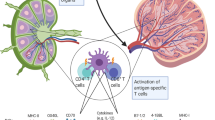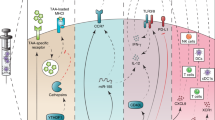Abstract
Until now, studies utilizing mRNA electroporation as a tool for the delivery of tumor antigens to human monocyte-derived dendritic cells (DC) have focused on DC electroporated in an immature state. Immature DC are considered to be specialized in antigen capture and processing, whereas mature DC present antigen and have an increased T-cell stimulatory capacity. Therefore, the consensus has been to electroporate DC before maturation. We show that the transfection efficiency of DC electroporated either before or after maturation was similarly high. Both immature and mature electroporated DC, matured in the presence of an inflammatory cytokine cocktail, expressed mature DC surface markers and preserved their capacity to secrete cytokines and chemokines upon CD40 ligation. In addition, both immature and mature DC can be efficiently cryopreserved before or after electroporation without deleterious effects on viability, phenotype or T-cell stimulatory capacity including in vitro antigen-specific T-cell activation. However, DC electroporated after maturation are more efficient in in vitro migration assays and at least as effective in antigen presentation as DC electroporated before maturation. These results are important for vaccination strategies where an optimal antigen presentation by DC after migration to the lymphoid organs is crucial.
This is a preview of subscription content, access via your institution
Access options
Subscribe to this journal
Receive 12 print issues and online access
$259.00 per year
only $21.58 per issue
Buy this article
- Purchase on Springer Link
- Instant access to full article PDF
Prices may be subject to local taxes which are calculated during checkout







Similar content being viewed by others
References
Pardoll DM, Topalian SL . The role of CD4+ T cell responses in antitumor immunity. Curr Opin Immunol 1998; 10: 588–594.
Hung K et al. The central role of CD4(+) T cells in the antitumor immune response. J Exp Med 1998; 188: 2357–2368.
Steinman RM . The dendritic cell system and its role in immunogenicity. Annu Rev Immunol 1991; 9: 271–296.
Cella M, Sallusto F, Lanzavecchia A . Origin, maturation and antigen presenting function of dendritic cells. Curr Opin Immunol 1997; 9: 10–16.
Banchereau J, Steinman RM . Dendritic cells and the control of immunity. Nature 1998; 392: 245–252.
Bell D, Young JW, Banchereau J . Dendritic cells. Adv Immunol 1999; 72: 255–324.
Banchereau J et al. Immunobiology of dendritic cells. Annu Rev Immunol 2000; 18: 767–811.
Guermonprez P et al. Antigen presentation and T cell stimulation by dendritic cells. Annu Rev Immunol 2002; 20: 621–667.
Fong L, Engleman EG . Dendritic cells in cancer immunotherapy. Annu Rev Immunol 2000; 18: 245–273.
Steinman RM, Dhodapkar M . Active immunization against cancer with dendritic cells: the near future. Int J Cancer 2001; 94: 459–473.
Brossart P, Wirths S, Brugger W, Kanz L . Dendritic cells in cancer vaccines. Exp Hematol 2001; 29: 1247–1255.
Banchereau J, Schuler-Thurner B, Palucka AK, Schuler G . Dendritic cells as vectors for therapy. Cell 2001; 106: 271–274.
Gilboa E . The makings of a tumor rejection antigen. Immunity 1999; 11: 263–270.
Tuyaerts S et al. Generation of large numbers of dendritic cells in a closed system using Cell Factories. J Immunol Methods 2002; 264: 135–151.
Romani N et al. Proliferating dendritic cell progenitors in human blood. J Exp Med 1994; 180: 83–93.
Jonuleit H et al. Pro-inflammatory cytokines and prostaglandins induce maturation of potent immunostimulatory dendritic cells under fetal calf serum-free conditions. Eur J Immunol 1997; 27: 3135–3142.
Kirk CJ, Mule JJ . Gene-modified dendritic cells for use in tumor vaccines. Hum Gene Ther 2000; 11: 797–806.
Zhou Y, Bosch ML, Salgaller ML . Current methods for loading dendritic cells with tumor antigen for the induction of antitumor immunity. J Immunother 2002; 25: 289–303.
Mitchell DA, Nair SK . RNA-transfected dendritic cells in cancer immunotherapy. J Clin Invest 2000; 106: 1065–1069.
Ponsaerts P, Van Tendeloo VF, Berneman ZN . Cancer immunotherapy using RNA-loaded dendritic cells. Clin Exp Immunol 2003; 134: 378–384.
Thurner B et al. Vaccination with mage-3A1 peptide-pulsed mature, monocyte-derived dendritic cells expands specific cytotoxic T cells and induces regression of some metastases in advanced stage IV melanoma. J Exp Med 1999; 190: 1669–1678.
Santin AD et al. Induction of human papillomavirus-specific CD4(+) and CD8(+) lymphocytes by E7-pulsed autologous dendritic cells in patients with human papillomavirus type 16- and 18-positive cervical cancer. J Virol 1999; 73: 5402–5410.
Chen CH, Wu TC . Experimental vaccine strategies for cancer immunotherapy. J Biomed Sci 1998; 5: 231–252.
Tobery TW, Siliciano RF . Targeting of HIV-1 antigens for rapid intracellular degradation enhances cytotoxic T lymphocyte (CTL) recognition and the induction of de novo CTL responses in vivo after immunization. J Exp Med 1997; 185: 909–920.
Tobery T, Siliciano RF . Cutting edge: induction of enhanced CTL-dependent protective immunity in vivo by N-end rule targeting of a model tumor antigen. J Immunol 1999; 162: 639–642.
Varshavsky A . Recent studies of the ubiquitin system and the N-end rule pathway. Harvey Lect 2000; 96: 93–116.
Bonini C, Lee SP, Riddell SR, Greenberg PD . Targeting antigen in mature dendritic cells for simultaneous stimulation of CD4+ and CD8+ T cells. J Immunol 2001; 166: 5250–5257.
Lin KY et al. Treatment of established tumors with a novel vaccine that enhances major histocompatibility class II presentation of tumor antigen. Cancer Res 1996; 56: 21–26.
Thomson SA et al. Targeting a polyepitope protein incorporating multiple class II-restricted viral epitopes to the secretory/endocytic pathway facilitates immune recognition by CD4+ cytotoxic T lymphocytes: a novel approach to vaccine design. J Virol 1998; 72: 2246–2252.
Su Z et al. Enhanced induction of telomerase-specific CD4(+) T cells using dendritic cells transfected with RNA encoding a chimeric gene product. Cancer Res 2002; 62: 5041–5048.
Gilboa E, Nair SK, Lyerly HK . Immunotherapy of cancer with dendritic-cell-based vaccines. Cancer Immunol Immunother 1998; 46: 82–87.
Nair SK et al. Induction of primary carcinoembryonic antigen (CEA)-specific cytotoxic T lymphocytes in vitro using human dendritic cells transfected with RNA. Nat Biotechnol 1998; 16: 364–369.
Heiser A et al. Human dendritic cells transfected with RNA encoding prostate-specific antigen stimulate prostate-specific CTL responses in vitro. J Immunol 2000; 164: 5508–5514.
Heiser A et al. Autologous dendritic cells transfected with prostate-specific antigen RNA stimulate CTL responses against metastatic prostate tumors. J Clin Invest 2002; 109: 409–417.
Heiser A et al. Human dendritic cells transfected with renal tumor RNA stimulate polyclonal T-cell responses against antigens expressed by primary and metastatic tumors. Cancer Res 2001; 61: 3388–3393.
Thornburg C, Boczkowski D, Gilboa E, Nair SK . Induction of cytotoxic T lymphocytes with dendritic cells transfected with human papillomavirus E6 and E7 RNA: implications for cervical cancer immunotherapy. J Immunother 2000; 23: 412–418.
Van Tendeloo VF et al. Highly efficient gene delivery by mRNA electroporation in human hematopoietic cells: superiority to lipofection and passive pulsing of mRNA and to electroporation of plasmid cDNA for tumor antigen loading of dendritic cells. Blood 2001; 98: 49–56.
Saeboe-Larssen S, Fossberg E, Gaudernack G . mRNA-based electrotransfection of human dendritic cells and induction of cytotoxic T lymphocyte responses against the telomerase catalytic subunit (hTERT). J Immunol Methods 2002; 259: 191–203.
Kalady MF et al. Enhanced dendritic cell antigen presentation in RNA-based immunotherapy. J Surg Res 2002; 105: 17–24.
Tuyaerts S et al. Induction of Influenza Matrix Protein 1 and MelanA-specific T lymphocytes in vitro using mRNA-electroporated dendritic cells. Cancer Gene Ther 2003; 10: 696–706.
Bonehill A et al. Efficient presentation of known HLA class II-restricted MAGE-A3 epitopes by dendritic cells electroporated with messenger RNA encoding an invariant chain with genetic exchange of class II-associated invariant chain peptide. Cancer Res 2003; 63: 5587–5594.
Milazzo C et al. Induction of myeloma-specific cytotoxic T cells using dendritic cells transfected with tumor-derived RNA. Blood 2003; 101: 977–982.
Larsson M et al. Requirement of mature dendritic cells for efficient activation of influenza A-specific memory CD8+ T cells. J Immunol 2000; 165: 1182–1190.
Lewalle P, Rouas R, Lehmann F, Martiat P . Freezing of dendritic cells, generated from cryopreserved leukaphereses, does not influence their ability to induce antigen-specific immune responses or functionally react to maturation stimuli. J Immunol Methods 2000; 240: 69–78.
Feuerstein B et al. A method for the production of cryopreserved aliquots of antigen-preloaded, mature dendritic cells ready for clinical use. J Immunol Methods 2000; 245: 15–29.
Romani N et al. Generation of mature dendritic cells from human blood. An improved method with special regard to clinical applicability. J Immunol Methods 1996; 196: 137–151.
Lee AW et al. A clinical grade cocktail of cytokines and PGE2 results in uniform maturation of human monocyte-derived dendritic cells: implications for immunotherapy. Vaccine 2002; 20 (Suppl 4): A8–A22.
Scandella E et al. Prostaglandin E2 is a key factor for CCR7 surface expression and migration of monocyte-derived dendritic cells. Blood 2002; 100: 1354–1361.
Langenkamp A, Messi M, Lanzavecchia A, Sallusto F . Kinetics of dendritic cell activation: impact on priming of TH1, TH2 and nonpolarized T cells. Nat Immunol 2000; 1: 311–316.
Ridge JP, Di Rosa F, Matzinger P . A conditioned dendritic cell can be a temporal bridge between a CD4+ T-helper and a T-killer cell. Nature 1998; 393: 474–478.
Bennett SR et al. Help for cytotoxic-T-cell responses is mediated by CD40 signalling. Nature 1998; 393: 478–480.
Bonehill A et al. Messenger RNA-electroporated dendritic cells presenting MAGE-A3 simultaneously in HLA class I and class II molecules. J Immunol 2004; 172: 6649–6657.
Cella M et al. Inflammatory stimuli induce accumulation of MHC class II complexes on dendritic cells. Nature 1997; 388: 782–787.
Cella M et al. Maturation, activation, and protection of dendritic cells induced by double-stranded RNA. J Exp Med 1999; 189: 821–829.
Liao X et al. Transfection of RNA encoding tumor antigens following maturation of dendritic cells leads to prolonged presentation of antigen and the generation of high-affinity tumor-reactive cytotoxic T lymphocytes. Mol Ther 2004; 9: 757–764.
Van Meirvenne S et al. In vivo depletion of CD4+CD25+ regulatory T cells enhances the antigen-specific primary and memory CTL response elicited by mature mRNA electroporated dendritic cells. Mol Ther 2005 (in press).
Acknowledgements
Material from patient R12 (from which clone R12-C9 was derived) was kindly provided by Dr B Schuler-Thurner and Dr ES Schultz (University Hospital of Erlangen, Erlangen, Germany). We thank C Huysmans, E Borms and J Volkaert for the help with DC cultures, E Vaeremans and M Verbuyst for mRNA preparations, J Aerts for his useful discussions and critical review of the manuscript, R Andries and J Theunissen for their helpful technical suggestions and C Wildmann for providing the T-cell clones. This work was supported by grants to K Thielemans from the Onderzoeksraad (OZR) of the Vrije Universiteit Brussel (VUB), the Fund for Scientific Research-Flanders (FWO-Vlaanderen), the Flemish Institute for Science & Technology (IWT), the Ministry of Science (IUAP/PAI V), the FORTIS Bank, the Belgische Federatie voor Kankerbestrijding, the Brussels Region and BruCells.
Author information
Authors and Affiliations
Rights and permissions
About this article
Cite this article
Michiels, A., Tuyaerts, S., Bonehill, A. et al. Electroporation of immature and mature dendritic cells: implications for dendritic cell-based vaccines. Gene Ther 12, 772–782 (2005). https://doi.org/10.1038/sj.gt.3302471
Received:
Accepted:
Published:
Issue Date:
DOI: https://doi.org/10.1038/sj.gt.3302471
Keywords
This article is cited by
-
Immune response in piglets orally immunized with recombinant Bacillus subtilis expressing the capsid protein of porcine circovirus type 2
Cell Communication and Signaling (2020)
-
Bursopentin (BP5) from chicken bursa of fabricius attenuates the immune function of dendritic cells
Amino Acids (2014)
-
Langerhans-type and monocyte-derived human dendritic cells have different susceptibilities to mRNA electroporation with distinct effects on maturation and activation: implications for immunogenicity in dendritic cell-based immunotherapy
Journal of Translational Medicine (2013)
-
Langerhans Cells Favor Skin Flora Tolerance through Limited Presentation of Bacterial Antigens and Induction of Regulatory T Cells
Journal of Investigative Dermatology (2013)
-
Design of an Optimized Wilms’ Tumor 1 (WT1) mRNA Construct for Enhanced WT1 Expression and Improved Immunogenicity In Vitro and In Vivo
Molecular Therapy - Nucleic Acids (2013)



